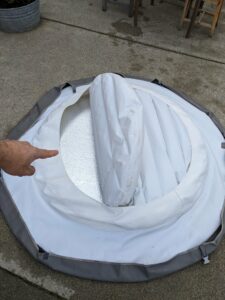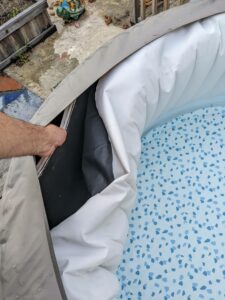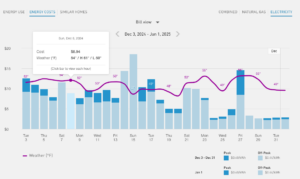Inflatable Hot Tub Electricity Costs
How much electricity does an inflatable hot tub use?
In brief, it costs $20-200 per month to operate an inflatable hot tub. A cover will reduce your electricity costs by about 20%.
If you want to compare electricity costs with other hot tub owners, you need to tell them:
– The average temperature in your area for the month. Google it or use this tool.
– How much your electricity costs per kilowatt-hour (in the US, it ranges from $0.08 to $0.50!) Google it.
——————————————————————-
Read on:
Here’s my experience: I live in the San Francisco Bay Area. I have a 177 gallon “4 person” inflatable hot tub that plugs into a regular 110 volt outlet. In the winter, our hot tub uses about 9 kilowatt-hours per day, with average outdoor temperatures of about 45 degrees. I added insulation, making it use about 20% less energy. In the summer, it uses 4 kilowatt-hours per day, with average temperatures 60-70.
Depending where you live, electricity costs $0.08 to $0.50 per kilowatt-hour. So if your electricity is expensive (like where I live), your hot tub may cost:
9 kilowatt-hours per day * $0.50 per kilowatt-hour * 30 days per month = $135 per month to operate in the winter.
Do the math for your area! If it’s colder, it’ll use more energy. If you’ve got a cover, it’ll use less energy, etc…
——————————————————————-
How much it costs to run just the pump?
My pump draws 35 watts. So running continuously thats 0.840 kilowatt-hours per day.
0.840 * 0.10 = $0.08 per day if your electricity is cheap.
0.840 * 0.50 = $0.42 per day if your electricity is expensive.
If you leave the pump running only 1/2 the time, it uses 1/2 the electricity.
——————————————————————-
How long does it take to warm up an inflatable hot tub?
Our 177 gallon tub warms at 2 degrees per hour in all of our conditions (40-70 degrees). So if we fill it with our 54 degree garden hose water, it’ll be at 104 in 50/2 = 25 hours. If we fill it with hot tap water, it’ll be ready immediately! (watch out, most garden hoses will be damaged with water over 120 degrees!)
——————————————————————-
Will I save money if I turn off my hot tub when I’m not using it?
For us, it takes 3 days of leaving the hot tub off to start saving any noticeable amount of electricity. It takes several hours (8-24) to get back to operating temperature so we leave it running unless we know we won’t use it for about a week.
We considered leaving the thermostat at 88 degrees when it’s not in use; since it warms up at 2 degrees per hour. We could turn the heat on in the morning and it’ll be ready when we come home in the evening. But meh, we usually just leave it running or turn it off for 3+ days at a time.
It’s good to know that you can turn it off entirely and be safe knowing the thermostat will automatically turn on the heat at about 36 degrees to keep it from freezing.
——————————————————————-
Should I get an insulating cover for my hot tub?
Meh. Our $100 Cleverspa cover saved us about $150 until it fell apart after a year. And it was a slight bother to put on every time. Maybe a more durable, better insulating cover would be worthwhile.
——————————————————————-
Should I insulate my hot tub with foam board insulation?
Possibly! 2 hours work and $50 of insulation is saving me 2kwh/day all winter, that’s ~$200/year. And it looks like it’s going to last several years! I used R-Tech 1/2 in. x 48 in. x 8 ft. R-1.93 EPS Rigid Foam Board Insulation from Home Depot. Though my electricity costs are very high; I pay $0.50/kwh, if you’re paying $0.10/kwh, a cover won’t save you money. But if you live in a place that’s cold, your heater probably can’t keep up without a cover, leaving you with an unsatisfying lukewarm hot tub!
——————————————————————-
Should I put my hot tub in an enclosure?
I haven’t tried one but many say they keep the heat in, which can be essential in a cold climate!
——————————————————————-
Should I put the hot tub in my basement or garage?
Sure. Watch out for humidity and mold though.
——————————————————————-
Details
I’ve kept track of our energy usage with an electricity power usage monitor (kuman KW47-US) and a smart plug (Kasa EP25).
In 2024, I asked my neighbors in the area on a FB group and 3 told me it added about $100/month to their electric bill, which is in line with my estimates.. My neighbor with a “real”, 6 person, hard sided hot tub uses about 7kwh/month in the winter, which is similar to mine!
Tracking costs methodically is hard to do! Confounding factors include usage (sitting in it uses more power than leaving it covered), daily outdoor temperature changes, modifying the hot tub temperature on occasion (our daughter plays in it at 100 degrees, not 104), turning it off or refilling it on occasion, not knowing when another person has changed the temperature, occasional poor note taking, etc. I’ve done my best to wade through the messy data to arrive at my conclusions.
Details: We have a 177 gallon, 180 cm diameter inflatable hot tub. We live in the east bay of San Francisco, CA. See The National Weather Service for a temperature almanac.
Update January 2025: here’s our electric bill from last month. When the hot tub was running, our electric bill was about $9/day with some exceptions. When it wasn’t running, our bill was about $3/day. That’s $6/day to run the hot tub!
Also notable is that I turned the hot tub off from the 24th-26th, turned it on the evening of the 26th, then off from the 28th-31st. If we had left it running, those 4 days would have cost $36, but they ended up costing $23. You’ve got to decide for yourself if it was worth it to leave the hot tub off of that time, to save that money.


